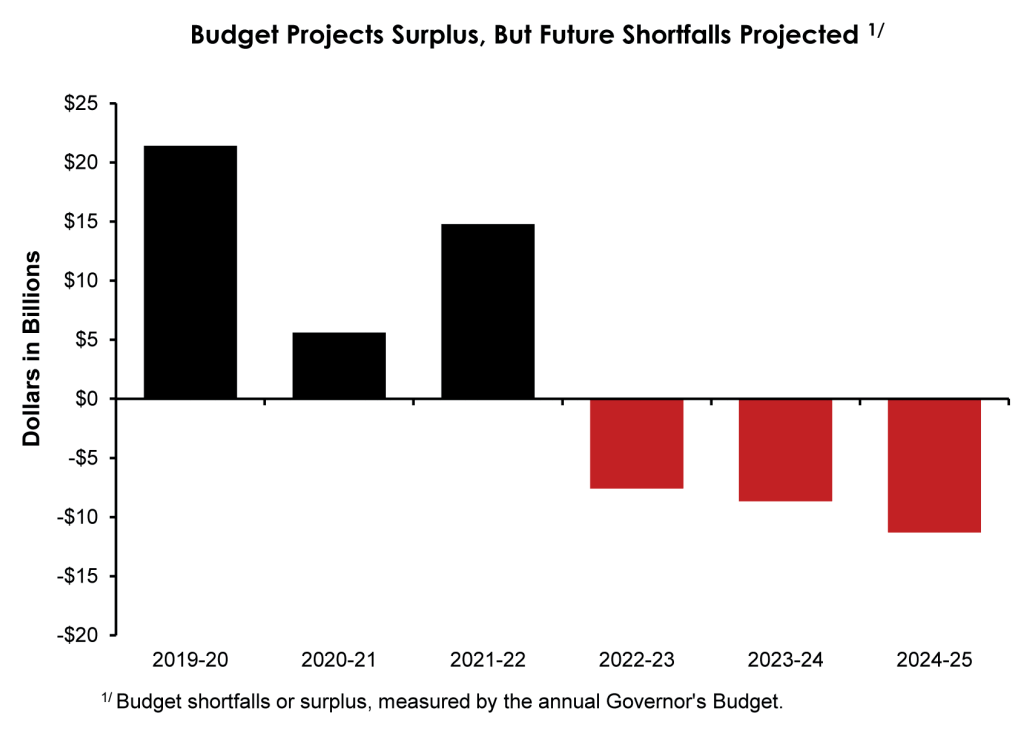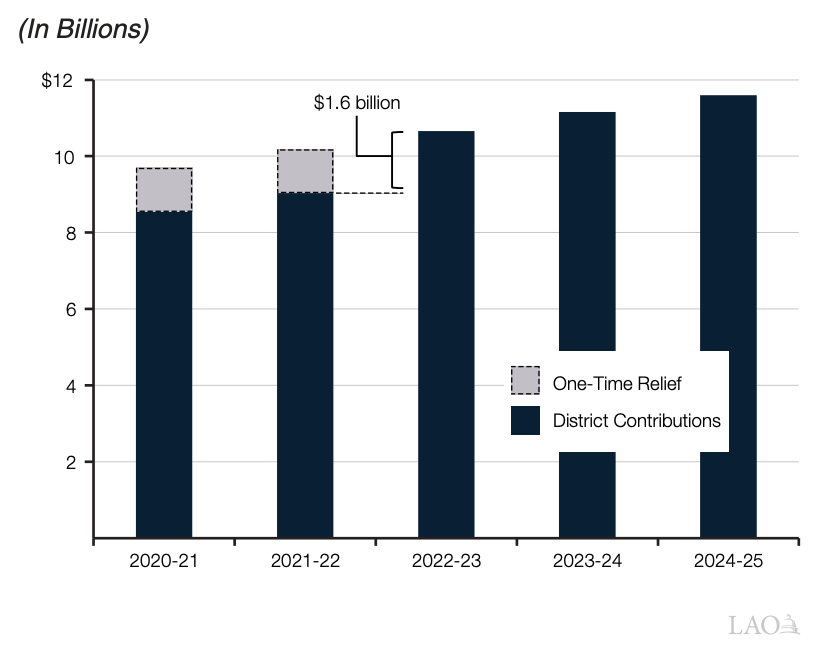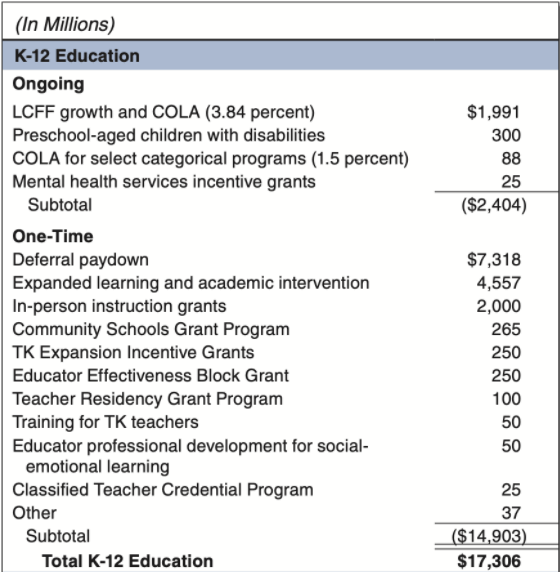Where is California's Education Budget Headed?

Will California schools get more money in 2021-2022?
In January, Governor Newsom announced his proposal for the state budget, the first major step in the annual budget process. The proposal reflects a financial windfall for schools, fueled by an unexpectedly buoyant stock market.
What does this windfall really mean? Do schools get a lot more money? It's complicated. In many ways, it depends on how you count, and what you define as “a lot.”
Let’s put California education funding in perspective. The chart below, from the Governor’s proposed budget for 2021-22, shows the growth of Prop. 98 funding over the past 10 years. Proposition 98, passed by voters in 1988, determines most of the funding for K-12 education and community colleges in California. (Proposition 98 funding comes from a combination of state funds mostly raised through income taxes, combined with local property tax revenues. It excludes federal funding and some state funds.)
In 2021, the Prop 98 budget proposed by the governor set a new record: $85.8 billion. The budget also commits an additional $2.3B in one-time money from the General Fund in recognition of the additional costs schools face as they respond to the Pandemic.
This is good news for schools, but context matters. Now take a look at another chart:
This chart shows the growth of the K-12 portion of Proposition 98 funding for K-12 schools — and it tells a more complete story. This chart is adjusted for inflation. Let’s say you can buy a loaf of bread for $2 in 2000. But now that same loaf costs $6. You are spending a lot more money today but getting that same loaf of bread.
So what is your answer? Do schools get a lot more money? Do you see “a lot” in these charts?
The Governor’s proposed budget
Each year the state forecasts how much revenue it will collect in taxes, and the Prop. 98 guarantee to schools is based on a share of that estimate. Last year, facing the growing shadow of the Pandemic and withering financial markets, the state prepared for the worst.
The worst did not happen. Unexpectedly, the stock market rebounded, and tax receipts grew with it. Now the state has to direct funding to education, as guaranteed under the law, based on actual revenue, not based on the early cautious guesstimate. That’s where the education “windfall” money comes from. This adjustment, known as settle up, is part of the normal process — but the size of the difference this year is abnormally large.
This year’s budget picture was sunnier than expected, but the Governor's budget forecasts storm clouds ahead.
With that as background, let’s take a look at 2021-22. Here is the answer to the question most people ask:
$12,648 per student in average daily attendance
The proposed education budget under Proposition 98 calls for K-12 expenditures of $12,648 per pupil in average daily attendance in 2021-22, which is $1,994 per pupil above the level cautiously set in the 2020 Budget Act. Under the Local Control Funding Formula (LCFF), some districts will get more and some will get less, mainly based on the portion of students in poverty or learning English.
California generally funds schools on the basis of roll call counts. Technically, funding flows to districts on the basis of average daily attendance (ADA), which on a statewide basis tends to be about 95% of enrollment. Few other states fund schools in this way, for sound reasons: attendance rates correlate with poverty rates, which vary from one school to the next. Attendance-based funding rules, like California's, systematically disadvantage the schools that serve the less advantaged. In this year of Pandemic-induced change, schools are struggling with declining enrollment and even worse challenges with attendance. For now, the state assumes that all schools have average attendance frozen at the level they had in February of 2020.
$64.5 billion. This is the total amount proposed for the Local Control Funding Formula (LCFF), the money that all school districts get out of Prop. 98. In normal years, funding allocated under LCFF includes an adjustment for changes in cost of living; last year’s budget skipped it. To make up for the lost year, the budget for 2021-22 funds a cost of living adjustment for both years, increasing LCFF funding by $2 billion. Note for advocates: There is some concern over why the budget for other education expenses, such as special education, did not get a similar Cost of Living adjustment.
Unraveling the impact of the Pandemic
Even though the state got significantly more money for schools than it anticipated, a lot of the money goes to pay off IOUs to school districts. This does not translate to a financial windfall for local schools.
Deferrals. Last year, out of concern that there would not be enough money to pay schools the full amount they were owed under the rules of Prop. 98, the state delayed payments to school districts. This practice is called a deferral. Last year the state deferred $12.5 billion, of which the Governor proposes to pay back $8.4 billion in July 2021. This is not really new money. It’s money to reimburse school districts for what they have already budgeted.
Rainy day reserves. The governor's budget directs some of the unexpected money— $3 billion— to be placed in reserve, as required by laws set by voters with the passage of Prop 2 (2014). Generally, deposits into these reserves accounts are required when revenue from capital gains is relatively strong and the Prop. 98 minimum guarantee is growing faster than per capita personal income.
Expenditures to Address the Pandemic. The budget proposes $6.6 billion in one-time funds for academic support ($4.6B) and reopening schools ($2B). The additional academic support targets disadvantaged students and can include summer school, longer school days, community learning hubs, and other locally developed interventions.
|
Examples of expenses that can be covered by Reopening School grants |
|---|
|
Salaries for certificated or classified employees providing in-person instruction or services |
|
Social and mental health support services provided in conjunction with in-person instruction |
|
COVID-19 testing |
|
Personal Protective Equipment (PPE) |
|
Ventilation and other site upgrades necessary for health and safety |
There is controversy over the Reopening Schools proposal on multiple fronts, including its quick timeline, how the money is distributed to school districts, and what it pays for. There are also re-opening issues relating to testing and vaccinations.
Extra state budget help beyond Prop 98
The state proposes to continue to provide education with extra help from the general fund because the level of Prop. 98 funding is too low to fully support education costs.
Supplemental Payments. Education funding in the 2020-21 budget was so low the state chipped in some extra money to keep schools afloat. These are called supplemental payments because they are in addition to the minimum guaranteed to the education system under Prop. 98. The payments were to grow from $2.3 billion in 2021-22 to more than $6 billion by 2024-25.
Ooops… change of plans. With the unexpected economic recovery, the Governor now proposes to eliminate these payments after 2021-22— making the $2.3 billion included in the 2021-22 budget a one-time payment. Education advocates are not happy with this revision.
Pension relief, temporarily. As explained in Ed100 Lesson 3.11, pensions for teachers and other employees are paid for by a combination of three sources: the state budget, the school district and the teachers themselves. The system has been badly underfunded for years, with an assumed rate of return on investments that hasn't panned out. School districts have been required to shoulder an increasing portion of the skyrocketing costs. The proposed budget offers districts some temporary support, as indicated in the chart below.
Pension costs to districts
Additional proposals in the budget
Federal relief funds
In addition to state funding, California anticipates receiving more than $6 billion from the Elementary and Secondary Schools Emergency Relief Fund, with 90% going directly to Title I schools. An additional $400 million is expected from the federally funded Governor’s Emergency Education Relief Fund. This is part of the COVID relief package passed in December. President Biden is supporting legislation for even more money as schools struggle to pay for the extra costs of the pandemic.
Investments Outside of Education
Too often, education advocates focus narrowly on what’s in the education portion of the budget. The important link between poverty and student achievement falls off the radar. Let’s not do that here, especially during a pandemic.
The Governor proposes substantial investments for low income families and small businesses that address the economic impact of the pandemic. The recovery package totals $14 billion, including $3.5 billion in immediate relief for individuals and small businesses disproportionately impacted by the pandemic. The Golden State Stimulus package includes tax refunds for low income workers. There are also targeted investments that address Housing and Homelessness, Labor and workforce development, and Health and Human Resources
A slew of new research continues to confirm that children do better in school when their families are supported with additional income, food support, tax credits, healthcare benefits and stable housing. It’s not just the education portion of the budget that affects schools. What distinguishes highly successful education systems is how they support children and families.
Read the Governor's K-12 Budget Summary for more details about the proposed state budget for education. For the even bigger picture see http://ebudget.ca.gov/
Immediate Action budget request
In normal times, California's budget process takes a few months to complete. In 2021, however, the Governor called for quick passage of a $5 billion Immediate Action Package, including $2B in Proposition 98 funding for reopening schools safely.
|
Immediate Action Package: |
||
|---|---|---|
|
Proposal |
Description |
Funding |
|
Reopen Schools |
$2,000 |
|
|
Safe Reopening of K-12 Schools |
Provide Proposition 98 General Fund for health and safety supplies and services to support in-person instruction for grades K-6 |
2,000 |
|
Direct Support for Workers and Small Businesses |
$3,046 |
|
|
Low-Income Tax Refund |
Provide tax refund payments of $600 to nearly 4 million low-income Californians |
2,400 |
|
Small Business Aid |
Provide additional funds for small business grants, including small non-profit cultural institutions. |
575 |
|
Fee Waivers for Heavily Impacted Service Industries |
Provide license and fee waivers for businesses and individuals heavily impacted by COVID-19, including those licensed by the Board of Barbering and Cosmetology and Department of Alcoholic Beverage Control. |
71 |
|
Total Immediate Action Package |
$5,046 |
|
Tags on this post
All Tags
A-G requirements Absences Accountability Accreditation Achievement gap Administrators After school Algebra API Arts Assessment At-risk students Attendance Beacon links Bilingual education Bonds Brain Brown Act Budgets Bullying Burbank Business Career Carol Dweck Categorical funds Catholic schools Certification CHAMP Change Character Education Chart Charter schools Civics Class size CMOs Collective bargaining College Common core Community schools Contest Continuous Improvement Cost of education Counselors Creativity Crossword CSBA CTA Dashboard Data Dialogue District boundaries Districts Diversity Drawing DREAM Act Dyslexia EACH Early childhood Economic growth EdPrezi EdSource EdTech Education foundations Effort Election English learners Equity ESSA Ethnic studies Ethnic studies Evaluation rubric Expanded Learning Facilities Fake News Federal Federal policy Funding Gifted Graduation rates Grit Health Help Wanted History Home schools Homeless students Homework Hours of opportunity Humanities Independence Day Indignation Infrastructure Initiatives International Jargon Khan Academy Kindergarten LCAP LCFF Leaderboard Leadership Learning Litigation Lobbyists Local control Local funding Local governance Lottery Magnet schools Map Math Media Mental Health Mindfulness Mindset Myth Myths NAEP National comparisons NCLB Nutrition Pandemic Parcel taxes Parent Engagement Parent Leader Guide Parents peanut butter Pedagogy Pensions personalized Philanthropy PISA Planning Policy Politics population Poverty Preschool Prezi Private schools Prize Project-based learning Prop 13 Prop 98 Property taxes PTA Purpose of education puzzle Quality Race Rating Schools Reading Recruiting teachers Reform Religious education Religious schools Research Retaining teachers Rigor School board School choice School Climate School Closures Science Serrano vs Priest Sex Ed Site Map Sleep Social-emotional learning Song Special ed Spending SPSA Standards Strike STRS Student motivation Student voice Success Suicide Summer Superintendent Suspensions Talent Teacher pay Teacher shortage Teachers Technology Technology in education Template Test scores Tests Time in school Time on task Trump Undocumented Unions Universal education Vaccination Values Vaping Video Volunteering Volunteers Vote Vouchers Winners Year in ReviewSharing is caring!
Password Reset
Search all lesson and blog content here.
Login with Email
We will send your Login Link to your email
address. Click on the link and you will be
logged into Ed100. No more passwords to
remember!


















Questions & Comments
To comment or reply, please sign in .
Anna Meza February 8, 2021 at 8:09 am
Carol Kocivar February 8, 2021 at 9:56 am
Todd Maddison February 1, 2021 at 4:56 pm
Is that included in the $12,648 quoted?
Carol Kocivar February 8, 2021 at 9:57 am